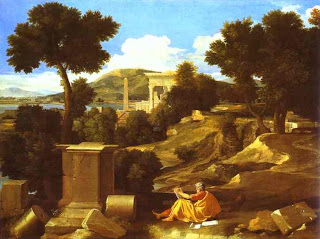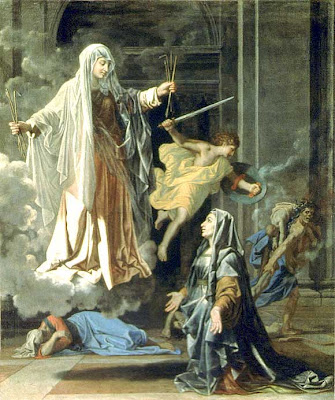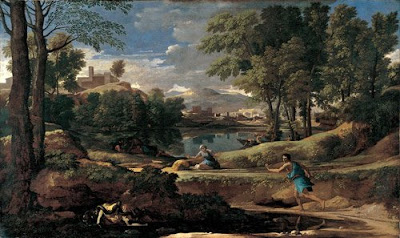Nicolas Poussin
Went to the Met yesterday to see the Poussin exhibit, mostly at the urging of Arthur Danto's review in The Nation (sorry, subscribers only). I am not a huge fan of landscapes; in fact, I remembered distinctly negative reactions to Poussin in my Art History survey course freshman year. I think I grouped him with Fragonard and Watteau as French Artists I Needn't Bother With.
 My exposure to him was limited to a few works, briefly displayed, and it seemed to me that his work was static and undramatic, albeit somewhat morose. Now, I like morose—my tastes shade to the dark and stormy—Bacon, Goya, El Greco, Grunewald, J.M.W. Turner, Piranesi, Caravaggio—but the works used in our class skipped Poussin's own (excellent) darker works and settled on things like St. John on Patmos.
My exposure to him was limited to a few works, briefly displayed, and it seemed to me that his work was static and undramatic, albeit somewhat morose. Now, I like morose—my tastes shade to the dark and stormy—Bacon, Goya, El Greco, Grunewald, J.M.W. Turner, Piranesi, Caravaggio—but the works used in our class skipped Poussin's own (excellent) darker works and settled on things like St. John on Patmos.
To me, this is somewhere between Jacques-Louis David and John Constable, which is like saying somewhere between flat and dull. There is little drama to be found here apart from the awkwardness of John's posture and the fact that an eagle (standing beside John) can't actually walk around like a crow, as it seems to be doing. Despite these unnatural elements, the nice trees and groping toward grandeur makes me quite bored.
If only the professor had put this up on the projector instead! Or this:
Or this: Or even this:
Or even this: But the exhibit, which is well-curated but, I find in researching this post, is missing most of the Louvre's excellent Poussins, forced me to look well beyond the overall tone of the painting, for Poussin is a master of subverting tone with detail. For instance:
But the exhibit, which is well-curated but, I find in researching this post, is missing most of the Louvre's excellent Poussins, forced me to look well beyond the overall tone of the painting, for Poussin is a master of subverting tone with detail. For instance:
 The tone of the painting, established not by the dimly lit foreground but by the well-lit and highly balanced middle ground and background, is neoclassical, ordered, harmonious. Yet in the foreground we have, as the title tells us, the ashes of Phocion being buried; but more disturbing are the postures of the man standing behind Phocion's wife and the figure hiding in the copse of trees to the right. The awkward contortions of the upright figure's posture and the unintelligible menace of the hiding figure begin to overwhelm the order of the rest of the composition; appearing to (perhaps) be staring at each other, the drama of their gaze(s) dominates the painting once you have noticed it.
The tone of the painting, established not by the dimly lit foreground but by the well-lit and highly balanced middle ground and background, is neoclassical, ordered, harmonious. Yet in the foreground we have, as the title tells us, the ashes of Phocion being buried; but more disturbing are the postures of the man standing behind Phocion's wife and the figure hiding in the copse of trees to the right. The awkward contortions of the upright figure's posture and the unintelligible menace of the hiding figure begin to overwhelm the order of the rest of the composition; appearing to (perhaps) be staring at each other, the drama of their gaze(s) dominates the painting once you have noticed it.
Poussin's work does much more than establish sharp juxtapositions between foreground and background, does more than just deploy contrasting tones within the painting. Often his choices of subject and detail seem to be esoteric, riddles almost, and frequently at odds with themselves. Danto's review describes in detail the many troubling puzzles present in Summer: Ruth and Boaz. I don't know how well the details will come out on your screen, but the proportions of the bodies of Ruth and Boaz seem to be wrong, while the leaves of the trees are perfect. The horses used in plowing are stallions more suited for chariot-drawing than for the plow. There is a man who appears to be blowing on something like a bagpipe. What is the rationale for any of this? Who knows—it is part of the wonderful strangeness of Poussin.
I don't know how well the details will come out on your screen, but the proportions of the bodies of Ruth and Boaz seem to be wrong, while the leaves of the trees are perfect. The horses used in plowing are stallions more suited for chariot-drawing than for the plow. There is a man who appears to be blowing on something like a bagpipe. What is the rationale for any of this? Who knows—it is part of the wonderful strangeness of Poussin.
 My exposure to him was limited to a few works, briefly displayed, and it seemed to me that his work was static and undramatic, albeit somewhat morose. Now, I like morose—my tastes shade to the dark and stormy—Bacon, Goya, El Greco, Grunewald, J.M.W. Turner, Piranesi, Caravaggio—but the works used in our class skipped Poussin's own (excellent) darker works and settled on things like St. John on Patmos.
My exposure to him was limited to a few works, briefly displayed, and it seemed to me that his work was static and undramatic, albeit somewhat morose. Now, I like morose—my tastes shade to the dark and stormy—Bacon, Goya, El Greco, Grunewald, J.M.W. Turner, Piranesi, Caravaggio—but the works used in our class skipped Poussin's own (excellent) darker works and settled on things like St. John on Patmos.To me, this is somewhere between Jacques-Louis David and John Constable, which is like saying somewhere between flat and dull. There is little drama to be found here apart from the awkwardness of John's posture and the fact that an eagle (standing beside John) can't actually walk around like a crow, as it seems to be doing. Despite these unnatural elements, the nice trees and groping toward grandeur makes me quite bored.
If only the professor had put this up on the projector instead!
 Or this:
Or this: Or even this:
Or even this: But the exhibit, which is well-curated but, I find in researching this post, is missing most of the Louvre's excellent Poussins, forced me to look well beyond the overall tone of the painting, for Poussin is a master of subverting tone with detail. For instance:
But the exhibit, which is well-curated but, I find in researching this post, is missing most of the Louvre's excellent Poussins, forced me to look well beyond the overall tone of the painting, for Poussin is a master of subverting tone with detail. For instance: The tone of the painting, established not by the dimly lit foreground but by the well-lit and highly balanced middle ground and background, is neoclassical, ordered, harmonious. Yet in the foreground we have, as the title tells us, the ashes of Phocion being buried; but more disturbing are the postures of the man standing behind Phocion's wife and the figure hiding in the copse of trees to the right. The awkward contortions of the upright figure's posture and the unintelligible menace of the hiding figure begin to overwhelm the order of the rest of the composition; appearing to (perhaps) be staring at each other, the drama of their gaze(s) dominates the painting once you have noticed it.
The tone of the painting, established not by the dimly lit foreground but by the well-lit and highly balanced middle ground and background, is neoclassical, ordered, harmonious. Yet in the foreground we have, as the title tells us, the ashes of Phocion being buried; but more disturbing are the postures of the man standing behind Phocion's wife and the figure hiding in the copse of trees to the right. The awkward contortions of the upright figure's posture and the unintelligible menace of the hiding figure begin to overwhelm the order of the rest of the composition; appearing to (perhaps) be staring at each other, the drama of their gaze(s) dominates the painting once you have noticed it.Poussin's work does much more than establish sharp juxtapositions between foreground and background, does more than just deploy contrasting tones within the painting. Often his choices of subject and detail seem to be esoteric, riddles almost, and frequently at odds with themselves. Danto's review describes in detail the many troubling puzzles present in Summer: Ruth and Boaz.
 I don't know how well the details will come out on your screen, but the proportions of the bodies of Ruth and Boaz seem to be wrong, while the leaves of the trees are perfect. The horses used in plowing are stallions more suited for chariot-drawing than for the plow. There is a man who appears to be blowing on something like a bagpipe. What is the rationale for any of this? Who knows—it is part of the wonderful strangeness of Poussin.
I don't know how well the details will come out on your screen, but the proportions of the bodies of Ruth and Boaz seem to be wrong, while the leaves of the trees are perfect. The horses used in plowing are stallions more suited for chariot-drawing than for the plow. There is a man who appears to be blowing on something like a bagpipe. What is the rationale for any of this? Who knows—it is part of the wonderful strangeness of Poussin.
Comments